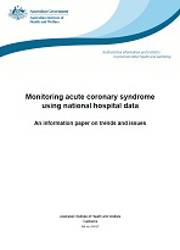Summary
The term ‘acute coronary syndrome’ (ACS) refers to the spectrum of acute coronary artery diseases spanning acute myocardial infarction (AMI) and unstable angina (UA). They are sudden, severe and life-threatening events.
Currently there is no way to directly count the number of ACS events at a national level. Instead, estimates are derived using an algorithm developed in the late 1990s, based on national hospital and deaths data. However, over the past decade, considerable changes have occurred in diagnostic techniques, clinical practice and the coding of diseases in hospital data. It is timely, therefore, to review the algorithm for estimating the incidence of ACS events.
As a first step, this report examines the trends and patterns in hospital data in relation to ACS, looking in detail at those factors most likely to impact on the ACS algorithm. The findings from the analysis reflect the changing patterns of diagnosis, care and treatment for hospital patients with ACS. In summary:
- The number of AMI and UA hospitalisations increased between 1993–94 and 2007–08 (79.5% and 33.1%, respectively). In 2007–08 there were almost 56,000 hospitalisations for AMI and 39,000 for UA. Note that, due to hospital transfers, one ACS event may be associated with multiple hospitalisations.
- The rate of transfer associated with ACS hospitalisations has increased over the past decade.
- The length of stay for ACS hospitalisations has declined.
- The proportion of AMI hospitalisations ending in death in hospital almost halved over the period from 1998–99 to 2007–08.
- The number and rate of cardiac procedures have increased considerably.
As ACS deaths are included in the incidence algorithm, mortality data are also briefly examined in this report. In 2007, 22,729 people died from coronary heart disease (CHD). Half of these had AMI recorded as the underlying cause of death.
Finally, the report presents a range of alternative algorithms for the estimation of ACS incidence based on results from the analysis. It is not currently possible to validate these against independent counts of ACS.
Despite differences in the actual estimates, all algorithms show the same trend direction, with a decline in the incidence of ACS events and case-fatality over the past 10 years.
Preliminary material: Acknowledgments; Abbreviations
1 Introduction
- Background
- Objectives
- Structure of report
2 Background
- What do we mean by acute coronary syndrome (ACS)?
- Why monitor ACS events on a national level?
- How do we currently monitor ACS events?
- Why review the current method of estimating ACS events?
3 Data sources, codes and methods
- National Hospital Morbidity Database
- National Mortality Database
- Statistical methods
4 Issues that impact on monitoring ACS events using national hospital data
- Changes to coding and coding standards
- Changes in diagnostic tests
- Changes in clinical practice
- Monitoring ACS rather than acute myocardial infarction
5 Trends in hospitalisations for ACS
- Overview
- Length of stay
- Urgency of admission
- Transfers
- ACS hospitalisations ending in death
- Region of hospital
- Procedures for ACS events
6 Deaths
7 Alternative algorithms
- Options for consideration
- ACS events
- Case-fatality
- Main points to note from the alternative algorithms
8 Discussion and recommendations
- Monitoring ACS events at a national level
- The impact of change on national hospital data
- Trends in deaths that affect the estimation of fatal ACS events
- Alternative algorithms for estimating ACS events and case-fatality rates from existing administrative data
- Further work required
Appendixes
Appendix A: ICD-10-AM and ACHI codes
Appendix B: Statistical methods
Appendix C: Detailed tables
End matter: Glossary; References; List of tables; List of figures



